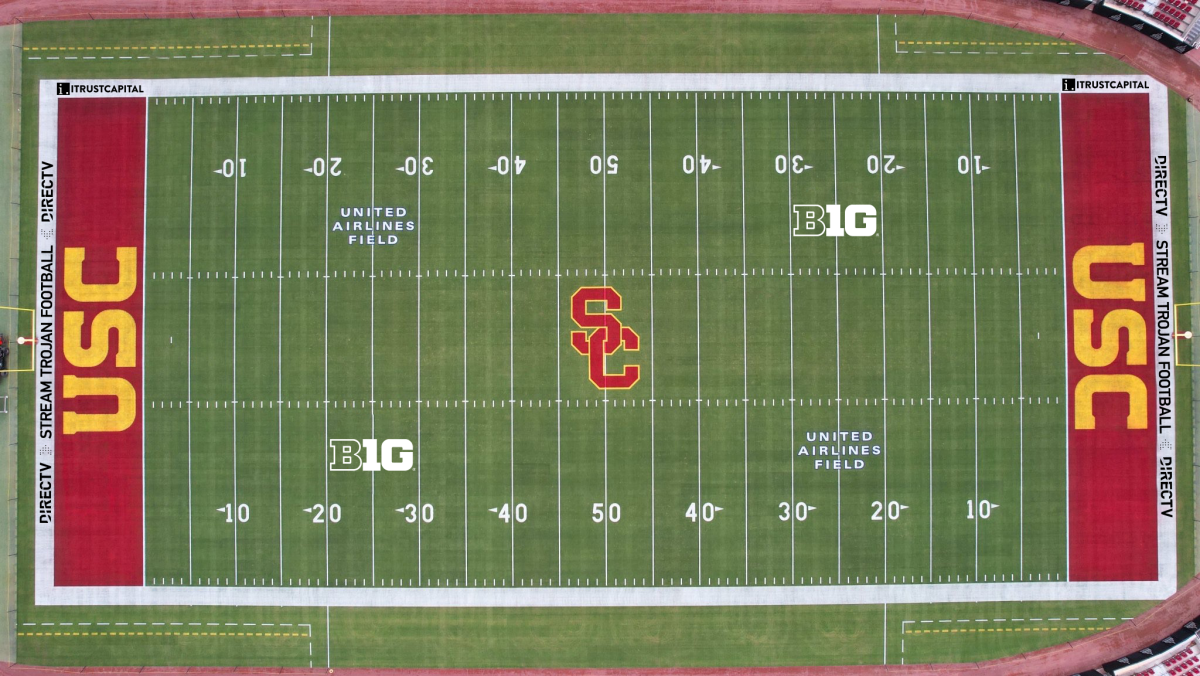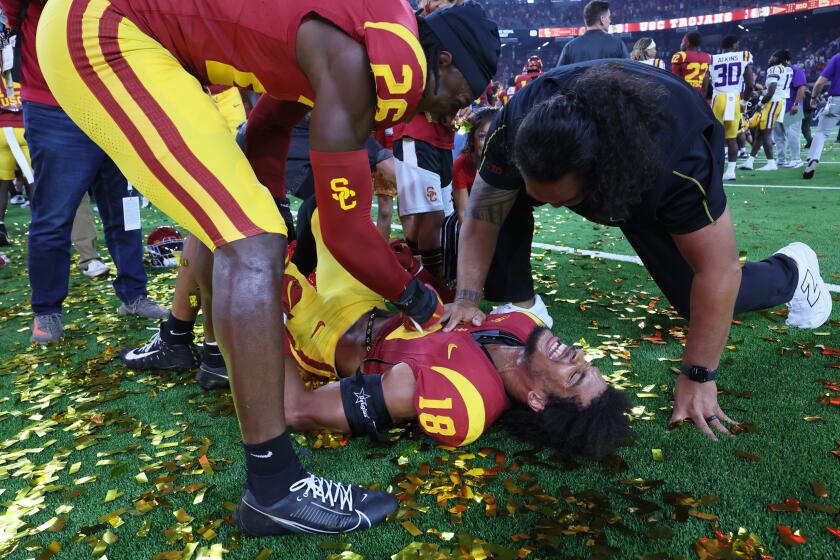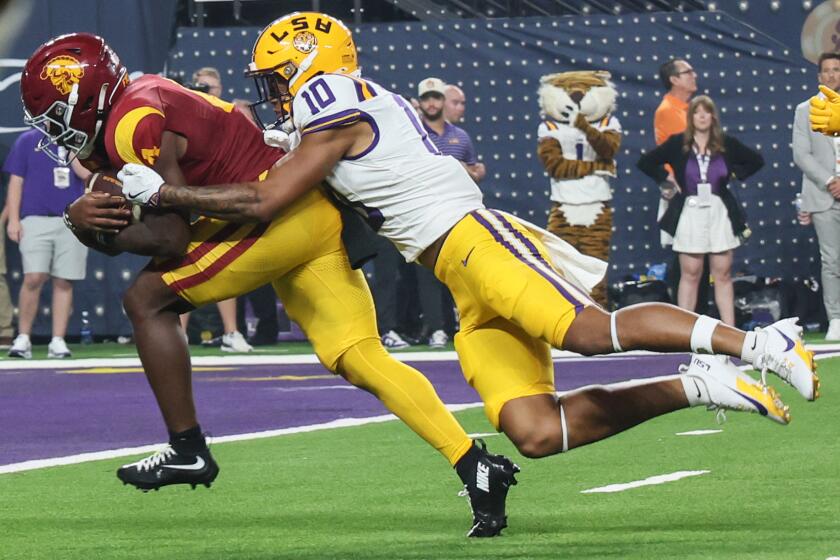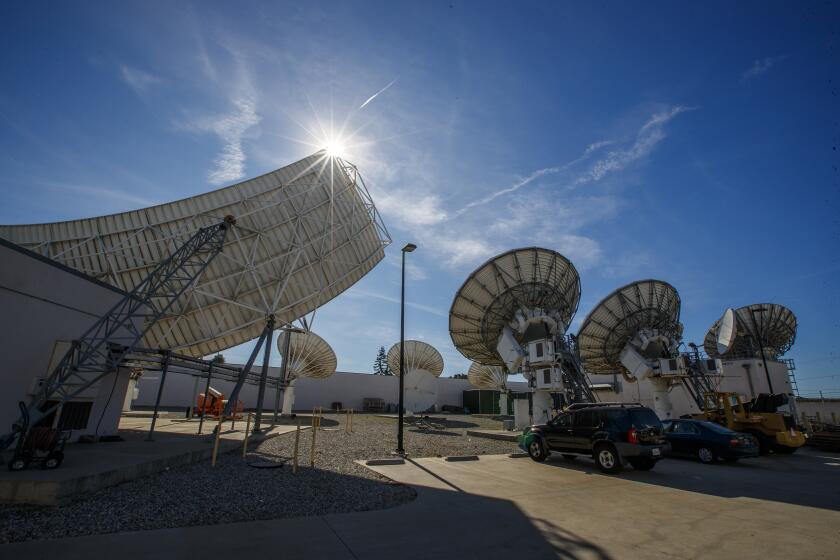Why USC sold Coliseum field space to DirecTV: It’s ‘an adapt-or-die scenario’

When USC fans get their first, long-awaited glimpse inside the L.A. Memorial Coliseum on Saturday night, they’ll be greeted by an unfamiliar sight at the back of both of the century-old stadium’s end zones.
An on-field sponsor ad, painted in black over the field’s white apron, urging them to “STREAM TROJAN FOOTBALL” on DirecTV.
That message might not have landed so well last weekend, after Disney pulled access to DirecTV amid a contract dispute, leaving more than 10 million in Southern California unable to watch USC’s season-opening win over Louisiana State on ESPN. But by Saturday, DirecTV will be front and center for all to see in the Coliseum end zone — assuming, of course, you have the Big Ten Network.
USC linebacker Eric Gentry knew the new Trojans’ new defensive coaches understood his skills. It showed during USC’s win over LSU Sunday.
USC will be among the first in college football to take advantage of the NCAA’s new rules allowing schools to sell on-field sponsorship ads. Even fewer have sold on-field ad space to a second sponsor like USC, which will display the logo of crypto investment platform iTrustCapital along one sideline boundary of the Coliseum’s end zones.
As athletic departments across the nation brace for revenue sharing and other costly changes to the landscape of college athletics, most stakeholders agree on-field corporate sponsors are just the beginning of college football’s march toward commercialization.
“There’s a lot of pressure to maximize their commercial revenue in a way that hasn’t really existed before,” said Christy Hedgpeth, president of PlayFly Sports Properties, which holds the multimedia rights to USC athletics and many other top college sports programs. “They’re being forced to consider things they might not have otherwise.”
The question, as schools seek out new sponsors and revenue streams, is where that line should be drawn.
At USC, that conversation began long before the NCAA changed its rules in June. In 2018, the university struck a 16-year, $69-million deal with United Airlines that would have renamed the stadium the “United Airlines Coliseum.” But that deal came under intense scrutiny when Janice Hahn, the president of the Coliseum Commission, spoke out fervently against it, suggesting that it “insults the memories” of World War I veterans “the Coliseum was intended to honor.”
Disney pulled its channels from DirecTV and U-Verse on Sunday, just minutes before a highly anticipated USC-LSU college football game. DirecTV has offered credits to customers as the blackout reflects building tensions in the TV industry.
The backlash nearly sunk the deal, which USC desperately needed to fund the stadium’s costly renovations. Ultimately, the two sides decided on an alternative. Instead of a deal to name the stadium, USC struck a 10-year deal with United for the naming rights to the field, which has since been named “United Airlines Field at the Los Angeles Memorial Coliseum.”
“United Airlines Field” has since been displayed prominently on both 25-yard lines, the most valuable on-field real estate that athletic directors can sell. Selling more of that real estate, without overwhelming fans with ads, is a delicate balance that many in the space still are trying to strike.
At USC, with its rich history and deeply entrenched traditions, officials have tried to be especially cognizant of where that line could be. USC football coach Lincoln Riley said Thursday that he’d “battled with” that balance too, but agrees a more commercial approach is inevitable. He called it “an adapt-or-die scenario.”
“We do have so much history and tradition here at USC, and that’s never going to go away,” Riley said. “But we also have to understand that the world around us is changing, and we can’t just sit there and only live on everything that’s happened in the past. It’s on us to find those balances, to honor that, but also not doing anything that would hamper our ability to climb, not just as a football program, but a whole athletic department.”
That approach aligned with DirecTV’s own intentions in the space. Josh Stern, DirecTV’s associate vice president of brand strategy and investments, said the goal was to catch fans’ attention but not upset them.
The ABC and ESPN blackout on DirecTV — affecting nearly 11 million homes — comes during a busy sports calendar with college football, the NFL and the U.S. Open tennis tournament.
There’s no “one-size approach” that fits all schools in determining that balance, Stern says. But he believes that fan tolerance is much higher than it once was. Still, some schools remain reluctant.
“I don’t think schools have carte blanche yet,” said Hedgpeth, the president of PlayFly Sports Properties. “Old habits die hard, and traditions are really sacred. These college programs, they’re older than most pro teams. You have such fervent, loyal, passionate, engaged fans. There’s definitely a segment of fan bases at some schools that have some pause.”
Those holdouts, however, are dwindling as athletic departments grow more desperate for new revenue streams. Hedgpeth, who worked with the NBA when it first welcomed corporate logos on jerseys, believes college football isn’t far from allowing similar jersey patches.
According to valuations released in June from Elevate, a sports business consultancy firm, upper-tier college football programs could command as much as $6 million per year for stitching a corporate logo to their school’s jersey. That’s no small chunk of change, considering the costs to come in college sports. But at what cost to tradition?
Riley thinks it’s possible to balance both.
“You see it happening in professional sports all over the place, at some of the most storied, successful franchises and organizations,” Riley said. “They’ve been able to have all the history and tradition you want, but also be able to adapt to a new world.”
More to Read
Go beyond the scoreboard
Get the latest on L.A.'s teams in the daily Sports Report newsletter.
You may occasionally receive promotional content from the Los Angeles Times.










